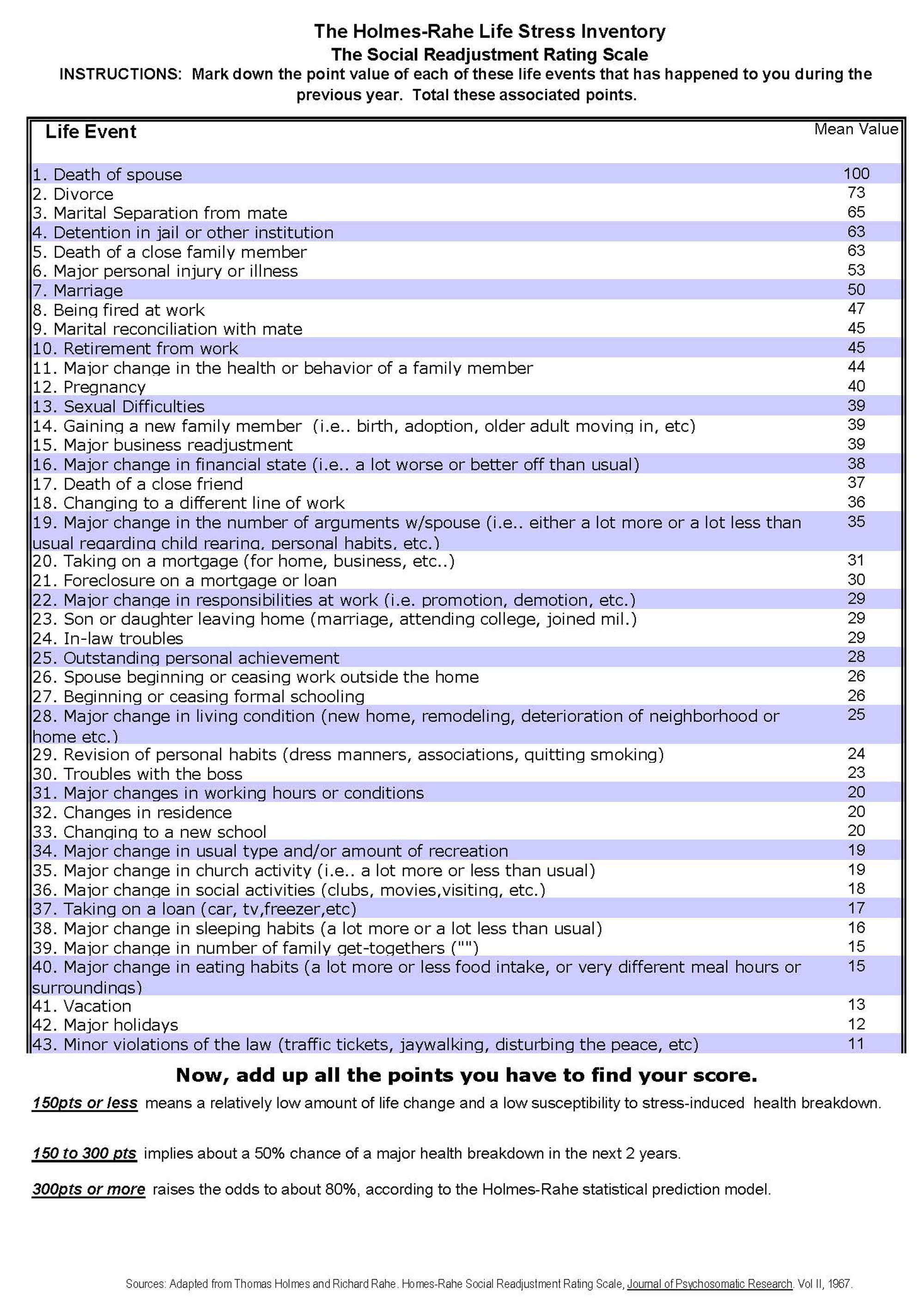On This Page:
The Social Readjustment Rating Scale (SRRS), often known as the Holmes and Rahe Stress Scale, was developed by Thomas Holmes and Richard Rahe in 1967.
The scale was designed to identify major stressful life events and was based on the premise that such events, regardless of whether they’re positive or negative, might necessitate significant adjustment and, hence, induce stress.
The SRRS comprises a list of 43 stressful life events, ranging from marriage and divorce to minor law violations and changes in sleeping habits.
Each of the 43 life events was awarded a Life Change Unit, depending on how traumatic it felt to be by a large sample of participants.
For example, “Death of a spouse” has the highest LCU value of 100, indicating it’s the most stressful event on the list.
By adding up the LCUs of events an individual has experienced over a year, one can get a score that predicts the likelihood of experiencing a major health breakdown in the subsequent two years. Higher scores indicate a higher risk.
- If a person has less the 150 life change units they have a 30% chance of suffering from stress.
- 150 – 299 life change units equate to a 50% chance of suffering from stress.
- Over 300 life units mean a person has an 80% chance of developing a stress related illness.
Social Readjustment Rating Scale (SRRS)

Empirical Research (Rahe, 1970)
The aim of this study was to investigate whether scores on the Holmes and Rahe Social Readjustment Rating Scale (SRRS) were correlated with the subsequent onset of illness.
Procedure: 2,500 male American sailors were given the SRRS to assess how many life events they had experienced in the previous six months. The total score on the SRRS was recorded for each participant.
Then over the following six-month tour of duty, detailed records were kept of each sailor’s health status. The recorded number of Life Change Units was correlated with the sailors’ illness scores.
Results: There was a positive correlation of +0.0118 between Life Change scores and illness scores. Although the positive correlation was small (a perfect positive correlation would be +1.00), it did indicate that there was a meaningful relationship between Life Change Units and health (this is often referred to as a statistically significant correlation). As Life Change Units increased, so did the frequency of illness.
The researchers concluded that as Life Change Units were positively correlated with illness scores, experiencing life events increased the chances of stress-related health breakdown. As the correlation was not perfect, life events cannot be the only factor contributing to illness.
Evaluation: The SRRS does not take individual differences into consideration. The scale assumes that each stressor affects people the same way. That is not necessarily true, e.g., for some people, divorce is extremely stressful, while for others, it can be amicable or even a relief.
Most people experience major life events very infrequently. Therefore a better measure of stress might look at the stresses and strains of daily life. These are called “daily hassles,” e.g., such as losing your keys.
Source of Stress: Daily Hassles & Uplifts
Most 43 life changes in the SRRS aren’t everyday events. Kanner et al. (1981) designed a Hassles Scale, which consists of 117 items, including concerns about losing things, traffic jams, arguments, disappointments, weight, and physical appearance.
Daily hassles are ‘irritating, frustrating, distressing demands that to some degree characterize everyday transactions with the environment’ (Kanner 1981) – i.e., the straw that broke the camel’s back!
Kanner et al. (1981) Empirical Study
Aim: Kanner et al. (1981) were interested in investigating whether it is daily hassles rather than major life events that are the most stressful. They developed a 117-item hassles scale and a 135 uplifts scale to examine the relationship between hassles and health.
Procedure: An opportunity sample of 100 American participants, including 52 women and 48 men, all white, well-educated, and middle class, were asked to circle the events on both scales that they had experienced the previous month and rate each according to severity (for the hassles) and frequency (for the uplifts).
Each participant was tested once a month for ten consecutive months using the two stress measures together with another two psychometric tests for psychological well-being.
| 117 Daily hassles | 135 Daily uplifts |
| about weight | recreation |
| rising prices | relations with friends |
| home maintenance | good weather |
| losing things | job promotion |
| physical appearance | eating out |
| crime | Getting enough sleep |
Results: They found the hassles scale tended to be a more accurate predictor of stress-related problems, such as anxiety and depression than the SRRS. Uplifts had a positive effect on the stress levels of women, but not men.
References
Holmes, T. H., & Rahe, R. H. (1967). The social readjustment rating scale. Journal of psychosomatic research, 11, 213.
Kanner, A. D., Coyne, J. C., Schaefer, C., & Lazarus, R. S. (1981). Comparison of two modes of stress measurement: Daily hassles and uplifts versus major life events. Journal of behavioral medicine, 4(1), 1-39.
Rahe, R. H., Mahan, J. L., & Arthur, R. J. (1970). Prediction of near-future health change from subjects” preceding life changes. Journal of Psychosomatic Research, 14(4), 401-406.

